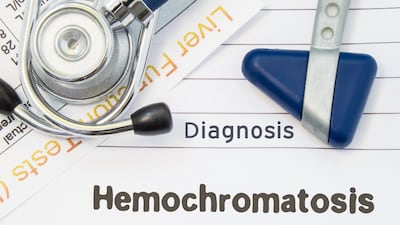Helen Keegan first suffered from pains in her joints and tiredness when she was studying for her Leaving Certificate.
“I was in and out of the doctors, complaining of being constantly tired and having sore joints,” the now 35-year-old explains. “I thought I might have arthritis. My mum thought I was silly and should be enjoying life but I thought there was something wrong.”
However in spite of her instincts, it wasn’t until she was 22 and living in Galway did she finally seek further tests. “I was driving home and my hand locked on the steering wheel. I knew that wasn’t normal so I went for more blood tests and finally the diagnosis of haemochromatosis was made,” explains Keegan. A genetic test confirmed the diagnosis.
Haemochromatosis, also known as iron overload, is an inherited condition which results in the body absorbing too much iron from food and storing this iron in organs. If the iron is not removed from the blood (through blood transfusions called phlebotomies), the build-up can result in long-term damage to the liver, heart and other organs.
Keegan started phlebotomy treatment in the Mayo University Hospital, Castlebar, every two to three weeks for three months. Then, once the iron levels in her blood were back at a normal level, she only needs to have phlebotomies three or four times a year. These are now done by her GP.
“I’ll know when I need to have one because of my level of tiredness. Family and friends even recognise when I need my bloods done,” explains Keegan. “I’m mindful of what I eat and avoid iron-rich foods, but otherwise I live a normal life.”
Lifestyle changes
Sarah Cagney (32) discovered her dad's brothers had haemochromatosis so decided to get tested for the condition in 2016. "I didn't have any symptoms but I decided to get checked so I asked my GP for a blood test and it was confirmed that I had haemochromatosis," explains Cagney.
Following her diagnosis, Cagney attended Louth County Hospital for fortnightly phlebotomies for five months and now has phlebotomies every six months. “It is reassuring how easily the condition is treated without medication. I’m lucky in that I haven’t had any huge lifestyle changes, but I am conscious of my alcohol consumption and I have reduced iron-rich foods in my diet.”
As the build-up of iron in the body is gradual with haemochromatosis, symptoms often don't appear until people are in their 30s. "Haemochromatosis is under-diagnosed partly because of lack of public awareness of the condition but also because symptoms like fatigue, depression and joint pain are confused with a range of other illnesses. However, undetected and untreated iron overload can result in premature death," says Margaret Mullett, the founder of the Irish Haemochromatosis Association.
Historically, people suffering from chronic fatigue, lack of vitality and generalised aches and pains in the joints were prescribed iron supplements without checking whether in fact, these symptoms were caused by too much iron in the blood.
A fervent campaigner for better awareness of the condition, Mullett says, “the tragedy is that so many people suffer harm unnecessarily when timely management of their condition [through blood donations] is simple, safe and effective. Haemochromatosis should not be a barrier to normal life”.
The Irish Haemochromatosis Association is campaigning for more Irish Blood transfusion service clinics to take blood from people with haemochromatosis. The support group is also calling for the removal of the charge of €80 that some hospitals have introduced for phlebotomies for those with haemochromatosis who don’t have a medical card or private health insurance.
FACTS ON HAEMOCHROMATOSIS
What is haemochromatosis? It is an inherited condition which results in the body absorbing and storing too much iron in the body. Also known as iron overload, it is caused by a mutation in the HFE genes and is the most common genetic disease in Ireland. One in 83 Irish people is predisposed to iron overload, compared with 1 in 200 people from other European countries. To have haemochromatosis, you must inherit this faulty gene from both parents.

What are the symptoms? Fatigue, depression and joint pain are common symptoms of haemochromatosis, all of which can be easily attributed to other conditions. If not diagnosed early and treated, the build-up of excess iron in the body can result in damage to organs over several years and conditions such as liver cirrhosis, arthritis and diabetes.
What else should I know about it? Not everyone with haemochromatosis has symptoms and some people only discover they have the condition through other family members. Women tend to have a later and less severe onset because of menstruation and pregnancy. The consumption of alcohol, a diet high in iron, obesity and hepatitis B and C increase the chance of clinical symptoms. Anyone with haemochromatosis should eat a well-balanced diet, drink plenty of water and avoid food supplements or tonics with iron and foods fortified with iron. Newly diagnosed people with haemochromatosis should also be screened for diabetes.
How is it diagnosed? Haemochromatosis can be diagnosed by a blood-based genetic test combined with a test to identify high levels of iron in the blood. This can be organised through your GP.
What is the treatment? The treatment involves regular removal of blood to reduce the levels of stored iron in the body. Known as venesection therapy or phlebotomy, this removal of the blood is similar to regular blood donation. Once iron levels are restored to normal, regular phlebotomy treatment results in normal life expectancy for those with haemochromatosis. Phlebotomy is carried out in primary care centres, hospitals and Irish Blood Transfusion Services (IBTS) clinics in Dublin and Cork. Haemochromatosis is not a blood disease and the blood donated can be safely used by the IBTS once the patient meets other criteria for blood donation.
For more, see haemochromatosis-ir.com or call 01-8735911.










